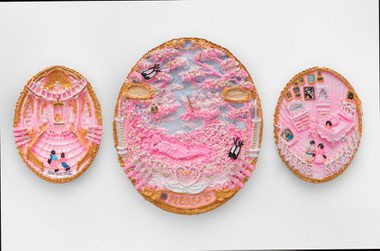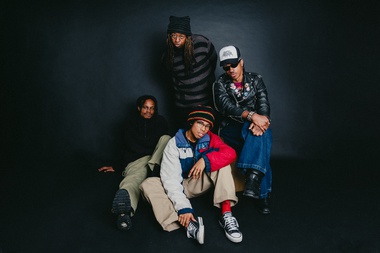Ellen DeGeneres wants me to win. And big! She cheers me on from inside her very own slot machine on the Sands convention floor.
The more she cheers, the more I want to keep playing. We’re united in the comfortable realm of daytime talk TV packaged in a casino-floor penny slot. When luck tilts in my favor, she dances across the 42-inch vertical touchscreen display, emitting sparkles. “I hope it’s bonus time,” she says. “I feel so alive.”
I, too, feel alive here at the Global Gaming Expo. All those cutesy objects appear in the slot machine’s multiplier. There’s The Ellen DeGeneres Show theme song and clips from TV. It’s video game/talk show/game show/slot mania like I’ve never seen.
“Couple that dance with a big win and you kind of wish you could reach out and give her a big hug,” says David Bollesen, studio director for gaming company International Game Technology.
I know, right?
Those old mechanical reels of the stepper slots are still popular in games of chance. But this! This is the future. This is multisensory, high-tech entertainment.
Here, animated cartoon characters walk down streets, dance, fly, speed around racetracks and slay dragons. Licensed brands bring pop culture to the casino floor with Duck Dynasty, Sons of Anarchy and Mad Men machines. Video slots with HD touchscreens have players poking birds and gravestones for prizes, and using joysticks on bonus rounds. All of this requires artists, designers, animators and tech pros in a way the gaming industry hasn’t before. Some come from the video-game world, others from tech.
“Making a game for this industry now, it’s a production.” says Bollesen, who worked in video gaming before joining IGT—the company behind the Ellen slot—15 years ago. “The creative is critical.”
At rival gaming giant Bally Technologies, it’s the same. Studios fill a chunk of the company’s headquarters in an office park off Sunset Road. Twenty of Bally’s 30 studios are here in Las Vegas, and each includes development directors, mathematicians, designers, artists, media techs and game engineers. They work on machines from the concept up.
“We consider us competing with the video-game world for the talent,” says Bally spokesman Mike Trask.
The machines often target audiences through pop-culture history: games like Wonder Woman with comic book fonts, television clips, soundtrack bites and leggy Lynda Carter in her star-spangled cape, red-bustier and sexy knee-high boots—that kitschy, ’70s-era symbol of female empowerment that rocked the imaginations of young girls (and boys) across the country. Players are going to spend on this nostalgic attraction, regardless of the odds.
Then there is Merkur Gaming, which has designed a gaming cabinet, a bubble-like enclosure that looks like something out of 2001: A Space Odyssey or an arcade game. It’s the physical manifestation of the psychological zone that players slip into at the slot banks.
All we’re missing are hologram slot machines (just kidding, hologram gaming already exists) and the ability to gamble in our sleep, playing our own unique dream sequences.
“Anybody can make a great game where you pull a slot. We’re constantly trying to come up with new ideas,” says Kim Cohn, Bally’s director of game development, whose studio (like the others) does everything from concept up, beginning with hand sketches, which are either team-generated or a directive from above.
Cohn majored in art at California State University, Northridge and worked as a technical director for Disney, doing mainly television and feature films before moving to Las Vegas in 2002 for her husband’s career. The closest thing to a job in digital and animation here was in slots, so she dove in, even though what the gaming industry was working on just 12 years ago “was much more primitive.”
Now in video slots, hair is flowing, leaves are falling, fog is moving and romance is budding. Artists are needed.
“There’s an expectation for this rich environment visually,” says Helga Watkins, coordinator for graphic design and media at UNLV, which has graduated students in gaming design. “And for artists, that’s engaging.
“Once upon a time you might be an illustrator who would draw out graphics and a technical artist might translate that into computer artwork,” Watkins explains. “Now the same person might be doing the skin, the logo, the animation, robust 3D graphics and thinking of a game theme, working on a concept. They get to originate ideas and narrative. Most artists in gaming are involved in the entire creative process.”
Paul Dixon, a media tech artist at Bally, originally planned to work in the entertainment industry, creating cartoons for Cartoon Network or at Pixar, but he chose a career in video gaming instead. “There are a lot of opportunities to do a lot of artwork, and chances to do 3D,” he says.
His colleague Samantha Robbins, an animator, graphic designer and illustrator at Bally, says the same. She’s into traditional 2D-animation films, old-school Disney style, and says working in gaming has allowed her to expand her creative development. “You’re expected to grow,” she says. “You can continually try something new. I think that prevents you from getting bored.”
Unlike in the entertainment world, which is more pigeonholed and in which people have “a specialty within a specialty,” Cohn says video slot designers appreciate working on teams where they’re able to use a wide range of skills.
At Bally, employees also spend considerable time in the company game room, testing machines before they’re finalized. That includes branded games like Wonder Woman, Betty Boop and Duck Dynasty, and the company’s original brands, which include a Cash Wizard series that was designed to read like a children’s story book. Every Cash Wizard game (there are three) introduces a new character and new setting. The second game brought the Cash Wizard’s wife, Ms. Magic. Game three includes their children.
For all the reports on the push to reach younger gamblers with sophisticated technology, catchy graphics and skill-based games, Bally’s Trask says the average slot player is over 45 years old and female. Walking through casinos, older adults, male and female, play slots that feature cute little kitty cats, cartoon characters and sparkly unicorns just as fit for a children’s birthday party as the casino landscape. Multiple-line pay, speed and animation heighten the stimulation.
“The gambling experience has evolved in step with technological innovation,” writes Natasha Dow Schüll in her book Addiction by Design: Machine Gambling in Las Vegas. “Once a relatively straightforward operation in which players bet a set amount on the outcome of a single payline, today machine gambling begins with a choice among games whose permutations of odds, stakes, size and special effects are seemingly endless.”
The MIT professor, who spent 15 years researching machine gambling, reminds us that we’re still talking slots here and the financial risk (even on penny slots) can be harrowing for problem gamblers.
In reporting the shifting role of slot machines in casinos—from having “lowly status” in the gambling economy to surpassing table games in revenue, casino real estate and gambler preference—Schüll addresses the ease of betting with today’s video slot machines.
In Nevada alone there are 176,073 slot machines (licensed for restricted and non-restricted venues), says Mike Lawton, senior research analyst for the Nevada Gaming Control Board. In the 32,255 square feet of gaming space in the state, slots take up 25,818 square feet—and this is with a diminishing number of slots in casinos, though there are more games on the floor. Lawton says a machine can now contain 50 or 60 games.
Within those games there might be saucy vixens (à la the seductress in the red bustier, thigh-high boots and tail who creates balls of fire in her hands during play of Red Hot Devil) or narratives with Viking raiders or car racers. Each one is an effort to grab the attention of those walking through the casino. But the gaming industry isn’t entirely different from other vice industries—junk food, big tobacco and alcohol, to name a few. Here, the lure is entertainment and the suggestion that a big win is on the horizon.
“We play a lot of slot machines,” Cohn says. “Not just here. We go out and play competitor’s machines. Look at what keeps a player playing.”
In the leave-no-genre-untouched think tanks, that might be Wonder Woman’s lasso of truth, the cast of Friends or Ellen dancing across my screen and egging me on to the bonus round. The sky’s the limit. Using autostereoscopic techniques, GTECH’s Sphinx 3D slot machine has the player moving through passageways, rooms and the landscape so effectively, online comments reference real motion sickness.
That doesn’t mean the one-bar spin classics will vanish. Bollesen at IGT says there will always be a spot for traditional machines on the casino floor. But what old-school machine will have Ellen dancing for your dollars?
The first slot machine
Looking back at the man who started it all
A Bavarian-born mechanic living in San Francisco is credited with building the first slot machine in 1895. Charles Fey’s machine inspired by other “gambling devices,” was so successful he built another, then another, finally quitting his job as a model maker for California Electric Works to open a slot factory on Market Street.
His coin-operated three-wheel Liberty Bell slot machine required users to pull a handle on the machine to spin the reels. If they lined up, the machine would pay the user in coins. A recent exhibit of Fey’s machines at the Nevada State Museum in Carson City referred to the inventor as the “Thomas Edison of Slot Machines” (as he was known to his peers). –Kristen Peterson













